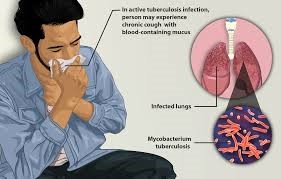By Asenath Were
During the most recent health awareness week, held from June 30 to July 4, at Uganda Christian University (UCU), the university collaborated with the Ministry of Health, the Infectious Diseases Institute (IDI), and USAID Local Partner Health Services tuberculosis (TB) Activity (LPHS) to increase TB awareness and prevention within the university community.
According to Dr. Geoffrey Mulindwa, director of UCU’s Allan Galpin Health Centre, TB is an airborne infectious disease transmitted through breathing and coughing. He states that this semester, one of the students living in a UCU residence hall had TB. This, he said, is not the very first case they have had. It is about the third if they consider a time period of about a year.
He emphasises the risk associated with this, namely that, “If someone is sharing a room at night with closed windows, they will undoubtedly infect others with their breath. But in this instance, safety precautions like isolation were implemented as soon as this was discovered, preventing the illness from spreading to others.”
“Therefore, as soon as we learned about it, we asked the district health services if they could check the other students who were in the same room as the TB patient, which they did, and discovered that they were disease-free,” he says.
Dr Mulindwa states that the number of cases of TB has increased recently by at least two or three times as a result of numerous factors that have lowered people’s immunity, such as HIV and poor nutrition. Rural-urban migration which has resulted in crowding, particularly in low-income housing areas, along with inadequate health services and awareness campaigns has also led to the increase.
During a training session on TB, which was held at UCU’s Principal’s Hall on June 19, in advance of the TB screening, Dr. Brian Wamala of the Ministry of Health highlighted some causes and risk Factors for TB.
Causes and symptoms
He explained that TB is caused by the bacterium mycobacterium tuberculosis, highlighting the higher prevalence among men and the significant number of undiagnosed and unreported cases.
“Symptoms such as persistent cough lasting over two weeks, unexplained weight loss, prolonged fever, unusual excessive sweating for children among other things are key indicators for tuberculosis,” Dr. Wamala stated.

Mulindwa also pointed out that TB is mainly associated with closeness, contact, and crowding. “There are so many incidences of vulnerability, like when we are moving in crowded transport, when we are at crowded events, anybody with a cough can spread it to others,” he says.
He added that tuberculosis is a disease that affects every part of the body: “You may have contracted it through the lungs, but it affects you right from the skin to the bones, that is to say, the eyes, brain, spinal cord, heart, lungs, stomach, intestines, bladder name it.”
“The good news is it is curable if identified early, the bad news is, it can kill if not identified early and treated in time. It can cause complications if it affects those different organs like the heart and the kidney. It requires a lot of discipline to avoid it,” Dr. Mulindwa cautioned.
One must therefore go to the nearest health centre for treatment.
“What we stress is that people who are diagnosed with the illness should take their medication as prescribed daily, finish their course of treatment, and be evaluated to determine whether they are cured,” he stressed.
Furthermore, he claims that the risk has always been those who are inconsistent with their TB treatment because, after the first two weeks, symptoms such as fever, chest discomfort, fullness in the abdomen, or diarrhoea resolve and they stop taking the drug, despite the fact that the treatment regimen is six months long.
As a result, even if they are given treatment, they will not improve since the germs get resistant to the medication as they consume it. And if someone coughs and spreads that infection, the next person will contract a bacterium that is already resistant to antibiotics.
Treatment
For treatment, he says, an individual is given a combination of antibiotics which are usually four drugs but might be combined in one or two tablets which you take daily. The amount reduces after two months but one should continue taking the medication for four more months to completely clear the disease out of one’s system.
He however urged everyone to stay hopeful because tuberculosis is treatable. Records at the Allan Galpin health centre show that two patients recovered after getting treatment, and one more is beginning their four-month course of treatment this semester.
The health centre is raising awareness of the disease and students are encouraged to spread awareness among their fellow students and seek diagnosis and treatment immediately, should they feel symptoms presenting.


